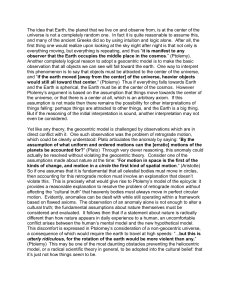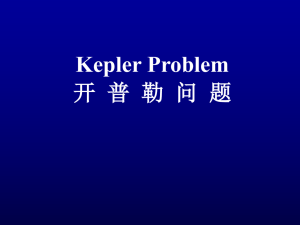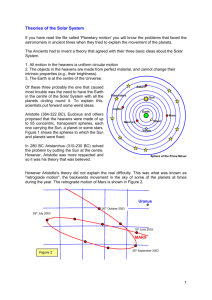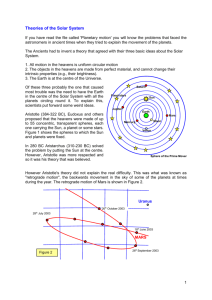L. Dixon On Epicycles and Ellipses - Università degli Studi di Bergamo
advertisement
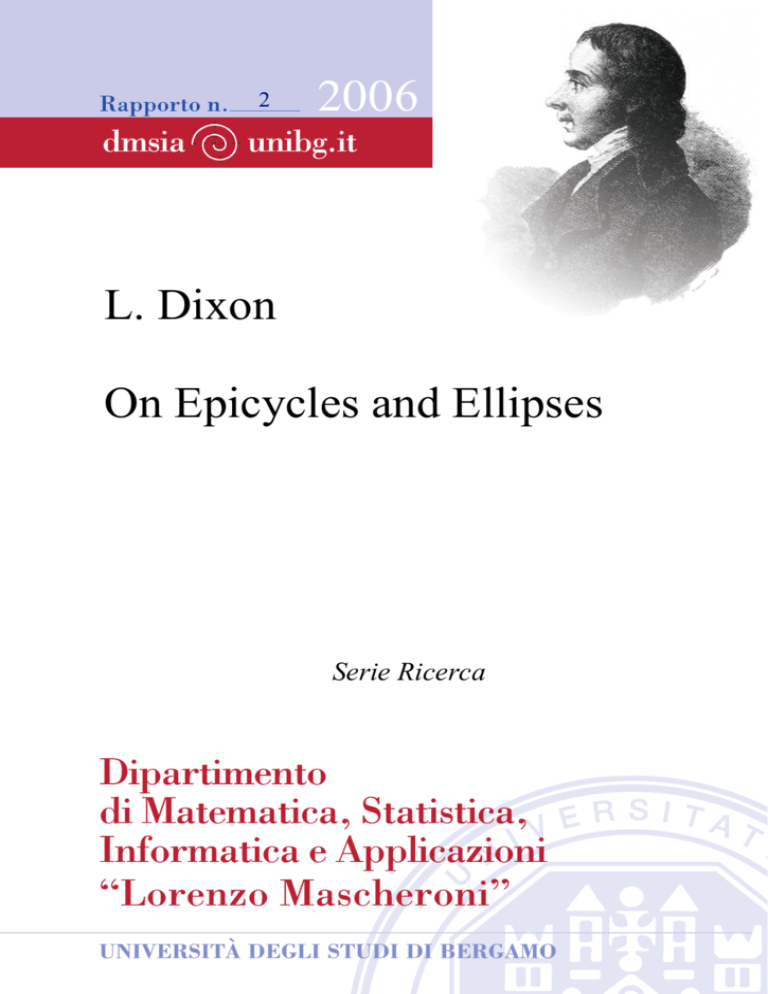
2 6 L. Dixon On Epicycles and Ellipses Serie Ricerca On Epicycles and Ellipses Laurence Dixon, Emeritus Professor, University of Hertfordshire June 2006 Introduction The ancient Greek astronomers invented models of the Solar system based on epicycles. The most famous of these astronomers was Ptolemy who lived in the second century AD, and it is his model that we will consider. By the fifteenth century the planets were not in the positions in the sky predicted by his model, and due to the observations of Tycho Brahe and the work of Copernicus, Kepler and Newton, a new model of the solar system was constructed based on ellipses. In this short note we will consider the differences between the two types of models and show that the differences in their prediction is not due to the reasons often stated. An Ellipse The parametric equation of an ellipse about its centre is usually given in the form X= a cos θ, Y= b sin θ and we will take this as our definition of an ellipse. With this definition if a>b then the major axis is along the X axis and the eccentricity E is calculated using b2 = a2 (1-E2). It is possible to expand this parametric representation by putting X= ((a+b)/2) cos θ + ((a-b)/2) cos (-θ), Y= ((a+b)/2) sin θ + ((a-b)/2) sin (-θ) having used the standard results that cos (-θ) = cos θ and sin (-θ) = - sin θ. An Epicycle An epicycle is defined as a circle of radius r rolling round a circle of radius R, so its parametric equation can be written as X= R cos α + r cos β, Y= R sin α + r sin β. Comparing these two expressions we see that any ellipse can be expressed accurately as an epicycle with R=(a+b)/2 and r=(a-b)/2 if β= -α and α= θ. These may be reversed to give a=R+r and b=R-r. Therefore every ellipse is identical to an epicycle, but not every epicycle is an ellipse. I am willing to admit that this came as a complete surprise, although I am sure it must be well known. It has some surprising implications. The usual Newtonian model of the Solar system assumes that, for most purposes, it is sufficiently accurate to describe the orbits of each planet as an ellipse with its focus at the Sun. If each ellipse is replaced by the equivalent epicycle , the model is just as accurate. The reason the model was changed was not therefore due to ellipses being better than epicycles. Heliocentric epicycles As in the standard gravitational model the Sun is at the focus of the ellipse, the Sun’s position is X= aE, Y=0. It is simple to express this position in terms of the epicycle parameters (aE)2 = a2 - b2 = (R+r)2 - (R-r)2 = 4Rr so the position of the focus is X= 2R√(r/R), Y=0. It therefore follows that if Ptolemy had used an origin at the Sun then a simple model that represented the orbit of each planet by a simple offset epicycle would have represented the orbits of the planets just as accurately as the Newtonian model based on ellipses. Retaining the X axis as the major axis of the orbit, the equation of the epicycle about the Sun as focus is X=2R√(r/R) + R cos θ +r cos θ, Y= R sin θ -r sin θ. As however each planet has a different major axis, we need next to select a constant direction, say north, and measure the angle of the major axis from it. Let this angle be ψ, then the equations become X=2R√(r/R) cos ψ + R cos (θ-ψ) +r cos ( θ+ψ), Y=-2R√(r/R) sin ψ + R sin (θ-ψ) - r sin ( θ+ψ). For most purposes the angle ψ can be treated as a constant during the motion of any planet, as are R and r, but for Mercury the precession of the major axis is a major factor in the argument for Einstein’s General Relativity Theory over against Newtonian gravity. If the need arose to include the precession in the epicycle model it just implies ψ is not a constant, which is remarkably simple to include in the model. Geocentric epicycles Ptolemy did not use the Sun as his origin, as all the observations available to him had been made from Earth, he preferred to work with the Earth as origin, though he acknowledged in the Almagest that a system based on a stationary sun would be mathematically simpler. Mathematically it is a simple change of co-ordinates to make the centre of the Earth the origin instead of the sun. We simply subtract the position of the earth from all other positions, so the position of the Sun XS, YS in the new system becomes XS = 0 - XE , YS = 0 - YE so in the new system the Sun will move round the Earth in an ellipse, of the same size and eccentricity as the Earth previously moved about the Sun. The same is, of course, true if we replace the ellipse by its equivalent simple epicycle. Each planet moves about the Sun on an ellipse which is equivalent to an epicycle consisting of two circular motions, XP,S YP,S given by the expression derived above. If we change the origin to the Earth the position of the planet about the Earth is X P,E =XP,S - XE, YP,E = YP,S - YE, so the orbit does accurately consist of four superimposed circular motions. People criticised Ptolemy for having epicycles upon epicycles but he would in fact have been correct if he had done this. We frequently approximate the elliptic orbits of the planets by a circular approximation. We make statements like “the radius of Earths orbit about the Sun is 1 au,” and “the radius of the orbit of Jupiter about the Sun is approximately 5 au,” both statements imply that a circular approximation is being used. Ptolemy did the same. He too often used circular approximations ,which simply implies setting r=0 and to this accuracy the orbit of a planet about the Earth is a simple epicycle with no offset term though sometimes he retained the offset term for the sun. A Historical Diversion Ptolemy wrote the Almagest in approximately 150AD, and his epicycle model became accepted throughout Europe. He proposed the heliocentric model and by the fifteenth century the astronomers were struggling to make their observations fit his model. At this point Nicolaus Copernicus 1473-1543, a mathematician, noting that the Earth rotates about its axis once a day, proposed that it rotated about the sun once a year. Copernicus’ seven propositions were 1 There is one centre of the universe. 2 The earths centre is not the centre of the universe 3 The Centre of the universe is near the sun 4 The distance of the earth is imperceptible compared to the stars 5 The rotation of the Earth accounts for the apparent daily rotation of the sun 6 The apparent annual cycle of movements of the sun is caused by the earth moving round the sun 7 The apparent retrograde motion of the planets is caused by the motion of the earth which is where we make our observations. It was his change to a heliocentric universe that got all the attention He continued to use an epicycle model and his had the advantage that because one of his epicycles in the motion of every planet was now due to the same motion of Earth about the Sun, he could now estimate the radii of the orbits of the planets relative to that of the Earth. He did however admit that his heliocentric model was no more accurate than Ptolemy’s model in fitting the observations The next major advance was due to Tycho Brahe (1546-1601). He was an observational astronomer and dedicated his life to recording the position of the planets as accurately as he could before the invention of the telescope. Brahe accepted Kepler (1571-1630) as his student , Kepler was a mathematician who analysed Brahe’s data and it was Kepler who showed that the data agreed with each orbit being an ellipse with the sun as its focus. He stated three propositions 1 Planets move in elliptical orbits with the sun at a focus 2 Planets sweep out equal areas in equal times 3 The orbits share a property that the square of the period is proportional to the cube of the semi-major axis a. He gave the numerical values to the parameters of the ellipses that matched Brahe’s observations , and that settled the question ellipses were in, epicycles were out. He never stated and may not have noticed that every ellipse is an epicycle, so if he had calculated the epicycle parameters that corresponded to his ellipses the epicycles would have fitted the data just as well Newton (1642-1727) showed that if two masses attract each other by his inverse square law of gravity the orbits are ellipses that satisfy Kepler’s three propositions and ever since it has been implied that Ptolemy’s model could not predict the planetary motion accurately but as we have seen it should do. Observations Let us return now to the observations that Ptolemy could have used. So far we have considered the relationship between position and angle and have shown that the epicycle model is as accurate as the more modern elliptic method. However when a planet’s motion is observed in the sky the observer has no direct way of estimating the distance of the planet from the earth. The information obtained consists of a sequence of observations of the angular position of the planet in the sky at known times t, and the model is then used to deduce the orbit. Newton showed that the angular momentum H of an elliptical orbit with the Sun as its focus remains constant. If ρ is the distance of the planet from the Sun and ϕ the angle between the radius vector and the major axis then H= ρ2 ϕ′. To connect angles with time in the epicycle model we need to derive the equivalent expression. The elliptical parameters are related to the position X, Y by ρ2 = X2 + Y2 and tan ϕ = Y/X Now if we differentiate ϕ we obtain sec 2 ϕ ϕ′ = (X Y′- YX′)/X2 But sec 2 ϕ = 1 + tan 2 ϕ = ( X2 + Y2)/ X2 So H= XY′ - YX′ And remembering that only θ is a function of time this gives H = (( 2R√(r/R) +(R + r) cos θ)( (R - r) cos θ ) + ((R - r) sin θ)((R + r) sin θ)) θ′ Rearranging we obtain H = (( 2R√(r/R))( (R - r) cos θ ) + ( R2 - r2)) θ′ So it is only the offset term that prevents θ′ being constant. This is not a simple relationship and Ptolemy could not have known it, not least, because he lived many centuries before Newton invented differentiation, so the expression θ′ would have been meaningless for him. He therefore had to approach the variation with time in a simpler way. If the expression is integrated over a complete orbit the integral of cos θ is zero, so taking θ′ as a constant gives the correct time for the end of each orbit and the slight errors in between are proportional to r and very small. However on a modern computer this relationship can be accurately integrated to give θ as a function of time and such a model should be as accurate as those based on ellipses. So what data did Ptolemy use? The Sun The most obvious object in the sky is the sun. From Earth mankind sees it circle the Earth each day and would soon come to recognise that it always goes round the same axis which can be used to define “North”. The direction “South” was just the opposite direction and “East” and “West” the directions orthogonal to North-South. Each day the highest point of the sun on its circuit can be used to define midday and the sun is noticeably higher in the sky at midday in summer than in winter. The summer solstice, the day when it is highest is now June 21 or 22, and the winter solstice the day when it is lowest is now December 21 or 22. The equinoxes occur when the sun rises and sets due East-West and now occur on March 20 or 21 and September 22 or 23. It is an easy task to count the number of days between these four events , and to realise that all four intervals are different. Approximate values of the intervals are 94.5, 92.5, 90 and 88 days, which of course sum to only 365 days in a year. The Greek astronomers knew better than this Meton and Eucteion gave the year as 365 +¼ +1/76 days Callipus used 365 +¼ days Hipparcus gave 365 +¼ - 1/300 days., which Ptolemy also used. But these astronomers, knowing this, did not quote the length of the seasons more accurately, neither do we on most occasions The number of days they quote in a year are very close to the modern value but we have no means of knowing if the number of days in a year did decrease between the time of Meton and Hipparcus as they imply or if they made a slight mistake. However using 365 days and the above four lengths of the seasons is sufficient data to calculate approximately the ratio of the radii r/R and the angle ψ between North South and the perihelion of orbit, which currently occurs on January 3rd. To get the correct answer would necessitate observing the lengths of the seasons more accurately so that they added to the correct length of the year, but given accurate data his method should give the correct values of r/R and ψ and so the correct eclipse. Ptolemy and Hipparcus gave the values r/R=1/24 and ψ =24.5 degrees for the Sun’s orbit The Planets When we view the path of the planets from the Earth over a long period they seem to trace out a complex path, but certain features of the path are very distinct and easy to observe. These features include the time needed for the planet to return to the same angular position in the sky, the date of the beginning and end of the period of retrograde motion , and the lengths of the periods of invisibility behind the sun. From this data Ptolemy could calculate the ratio Rp/ RE and the values of θp and θE for the planet and earth at a given time. In this epicycle the two angles are independent, unlike for an ellipse and the rate of change of each angle is constant. He did not ,as far as I could see, when I read a modern translation of the Almagest ever use the full four epicycle model. It therefore appears that, while Ptolemy’s full epicycle model of the solar system should have been as accurate as the elliptic model, it was never completely tested. He did not have a computer and can hardly be downgraded for not doing calculations that most modern astronomers would not attempt without one. The amazing thing is that Kepler managed to verify the elliptic model without a computer. Even so Ptolemy’s model accurately fitted the observations made by earlier Greek observers, and did it so well that a NASA astronomer , Robert Newton, wrote a book claiming Ptolemy committed fraud So why was Ptolemy’s model wrong by 1450 AD As far as I can see there are at least two possible explanations of why Ptolemy’s model should not have agreed with the observations made in the fifteenth century. The conventional explanation is that his four epicycle model was wrong. However we have shown it was correct. The model contains his values of R and r and ψ and these could have been wrong, indeed they must have been wrong or the observations would have agreed with the model. There are two possible reasons for this. Ptolemy may have computed the wrong values from his observations, this almost certainly have to be due to errors in the observations not in his trigonometry, but Robert Newton’s claims seem to rule this out. The second reason is more interesting as it is simply that the values of some of the parameters R, r, and ψ changed between 150 AD and 1430 AD. It will be interesting to compare the values recorded by Ptolemy with those corresponding to Kepler’s ellipses, to see which planetary orbits may have changed. Acknowledgments The content of this work pertains to topics of interest to SIS and to academic research 06 of University of Bergamo (E. Spedicato coordinator). Redazione Dipartimento di Matematica, Statistica, Informatica ed Applicazioni Università degli Studi di Bergamo Via dei Caniana, 2 24127 Bergamo Tel. 0039-035-2052536 Fax 0039-035-2052549 La Redazione ottempera agli obblighi previsti dall’art. 1 del D.L.L. 31.8.1945, n. 660 e successive modifiche Stampato nel 2006 presso la Cooperativa Studium Bergomense a r.l. di Bergamo
